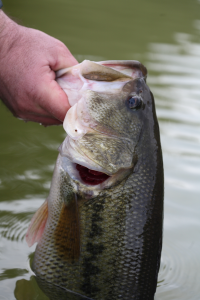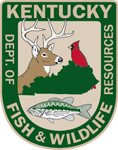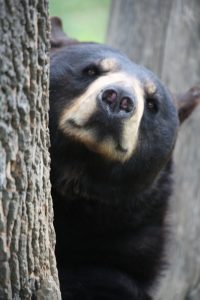
Photo: Kentucky Department Fish And Wildlife
The length of day relative to the time of year never changes. As the nights lengthen slightly with each passing day in fall, the overnight temperatures drop and pull heat from the top layers of lakes.
This development is already underway, but will peak over the next month and make excellent fishing conditions for black bass.
“The cooler, oxygenated water in the shallows draws baitfish and the bass follow to feed heavily,” said Jeff Ross, assistant director of fisheries for the Kentucky Department of Fish and Wildlife Resources. “The shorter days signal to bass that winter is coming and they must feed heavily in fall.”
The shallow movement of black bass, mainly largemouth bass, but a few spotted bass and even smallmouth on lakes that have them, presents the best bass fishing opportunities of the year for bank-bound anglers.
Water temperatures in Kentucky’s major reservoirs are in the mid-70s. When the temperatures drop into the 60s, bank anglers should hit the lower 1/3 of the main lake or major creek arm of our major reservoirs and the dam area of our smaller, state-owned lakes. You will have as good a chance at a 5-pound or better bass as someone with a bass boat that costs as much as many people’s homes.
Bank fishing, like wade fishing streams, returns anglers to a time when all they had was a small, one-tray tackle box and a Zebco 33 combo. You can concentrate on fishing, not fighting wind with a trolling motor or fiddling with a cranky sonar unit. You can bring one rod and one small tackle bag or box and have all you need.
Map study is paramount for finding productive spots to bank fish for bass in fall. Points with the old river or major creek channel running close to them are tops. Most of our major reservoirs have boat ramps and recreational areas in the lower areas of the main lake or a major creek arm that offer public bank access.
Our smaller, state-owned lakes have a 50-foot easement for the public to access the bank for fishing. Visit the Kentucky Fish and Wildlife website at www.fw.ky.gov and click on the “Find a Place To Fish” tab. Many of the state-owned lakes now have 5-foot contour maps and locations of fish attractors featured on this helpful web page.
“You can use a more active bait in fall, especially if you are fishing from the bank,” Ross said. “Crankbaits and spinnerbaits work well in fall. You don’t have to slow things down too much. When they are up shallow, they are pretty active.”
Medium-running crankbaits in shad-colors such as chrome and black work wonders as do white spinnerbaits with skirts of black, silver with touches of blue. “Keep moving and cover water,” Ross said. “You don’t have to be too fancy, just get the bait in front of the bass.”
You will catch mainly largemouth bass, but in the lower sections of lakes such as Lake Cumberland, Barren River Lake or Green River Lake that hold smallmouths, a marauding bronzeback may savage your lure, especially on overcast days. You may also pick up a football-shaped spotted bass. Spotted bass make excellent table fare. It generally benefits the black bass population in the lake if you harvest some spotted bass, one of the reasons they have no minimum size limit.
Boat ramps are another spot to catch bass, especially largemouths and spotted bass. Nearly all boat ramps have a gouge hole at the end of them from the blast of outboards scouring the bottom when trailering a boat. By mid-October, boat ramps get little action from boats, so working a crankbait over the gouge hole at the end of the ramp can produce fantastic action.
The riprap rock that armors the face of most reservoir dams also draws baitfish and bass in fall. “Dams hold those bass when they come shallow in fall and make really good fishing spots for bank anglers,” Ross said.
Crankbaits and spinnerbaits work well for fishing the dam riprap, but a large crappie minnow or small to medium shiner hooked through upper lip with a 1/0-circle hook and a couple of BB-sized split shot weights usually outfishes everything. Keep the outfit moving slowly to avoid hanging the split shot weights in the riprap. Bottom fishing live bait off channel points also works wonders in fall.
Fall is a delightful time to grab a rod, a small tackle bag and hit the bank. The weather is comfortable and the fish hungry.
 A dedication ceremony for the first pistol range built by the Kentucky Department of Fish and Wildlife Resources is set for 1 p.m. Oct. 23 at Kleber Wildlife Management Area in Owen County.
A dedication ceremony for the first pistol range built by the Kentucky Department of Fish and Wildlife Resources is set for 1 p.m. Oct. 23 at Kleber Wildlife Management Area in Owen County.
The new pistol pit is next to an existing tube rifle range at the area.
“We partnered with the National Rifle Association (NRA) and the National Shooting Sports Foundation on this project,” said Ben Robinson, assistant director of the department’s wildlife division. “They assisted with conventional range plans and our engineering division handled the final design. The NRA also contributed some match for the project, which was primarily funded using funds from the Wildlife Restoration Program, also known as the Pittman-Robertson Act.”
The department plans to build a similar pistol pit at its Otter Creek Recreation Area in Meade County.
High earth berms surround the pistol area on three sides for safety. Users can shoot at distances up to 15 yards.
Both ranges are free for public use on a first-come, first-serve basis. These self-service ranges are open from 9 a.m. until sunset Tuesday through Saturday, and from noon until sunset on Sunday. Facilities close on Mondays for maintenance. Persons using either range must have eye and ear protection.
Tube ranges are for rifles, muzzle loading guns and shotguns loaded with single projectile slugs. They are not for use by shooters using shotguns with pelleted loads. Participants at the pistol range may only use single projectile ammunition.
For more information about the Kleber WMA range, call (502) 535-6335. Find information about wildlife management areas and facilities offered on each property by going online to the Kentucky Fish and Wildlife website at fw.ky.gov.
The Kleber ranges are located at the end of Cedar Road. The GPS coordinates are 38.363614, -84.745104.

Photo: Kentucky Department Fish and Wildlife
Viewers of “Kentucky Afield” television picked up their phones and took to social media last weekend to submit more than 200 questions for the annual fall hunting call-in show.
Kentucky Department of Fish and Wildlife Resources wildlife biologists Gabe Jenkins and John Morgan, along with Sgt. Rufus Cravens of the department’s Law Enforcement Division, joined “Kentucky Afield” host Chad Miles for the hour-long show that aired live on Sept. 16 on Kentucky Educational Television. The panel could not get to all of the questions before the credits started rolling.
Below, Kentucky Fish and Wildlife personnel answered a handful of the questions that did not make it on-air. Viewers who missed the live show can watch a full replay on YouTube. Enter “KYAfield” in the search box on the YouTube homepage.
Will Kentucky Fish and Wildlife consider adjusting deer seasons due to the EHD (Epizootic Hemorrhagic Disease) outbreak? – Eddie from Morgan County
GABE JENKINS, Deer and Elk Program Coordinator, Kentucky Fish and Wildlife: We will not be implementing an emergency regulation to shorten or close deer season in 2017 in any county due to the EHD outbreak. We encourage folks to report all dead deer they find using our online reporting system.
After the outbreak has ceased, we will evaluate the number reported along with the harvest data from the 2017 season and make our recommendations for the 2018 season at the December meeting of the Fish and Wildlife Commission. Deer are prolific breeders, and the population will rebound within a couple years.
Lastly, if your area has experienced a severe die-off, I would encourage hunters to participate in some self-restraint and pass once you have taken enough deer to fill your freezer for the year.
How far west have elk traveled in Kentucky? – Wayne from Marion County
JENKINS: We receive reports of elk outside the elk zone almost every year. In the early years of elk restoration, we saw elk leave the elk zone more frequently. We’ve had reports of elk as far west as Lake Cumberland and one elk went to North Carolina. We have had elk harvested outside the elk zone in Bath, Carter, Laurel, Madison, Wayne and Wolfe counties.
What resources are available through Kentucky Fish and Wildlife to assist with wildlife habitat improvement? – Gary from Grayson
BEN ROBINSON, Wildlife Division Assistant Director, Kentucky Fish and Wildlife: Kentucky Fish and Wildlife is committed to assisting landowners with wildlife habitat improvement on their property. We employ more than 30 wildlife biologists who specialize in assisting private landowners with habitat management projects. From tips about improving food sources for deer and turkey to navigating cost share programs through the federal Farm Bill, we have someone available to assist you.
For more information, visit our web site at fw.ky.gov or call 1-800-858-1549 and ask for the phone number of your local private lands or farm bill biologist.
Does prescribed burning on private and public lands benefit wild turkeys? Where can I find more information? – Tony from Montgomery County
ROBINSON: Kentucky Fish and Wildlife considers prescribed fire an essential management tool for private landowners and publicly managed Wildlife Management Areas. Prescribed fires are carefully planned and managed by highly trained burn crews for containment to select areas.
We regularly use prescribed burning on grasslands and timbered areas to benefit a host of game and non-game species, including wild turkey.
Prescribed fire has many benefits. Fire removes old vegetation and stimulates new growth, providing a lush food source for wildlife. Fire promotes oak regeneration in our forests resulting in more acorns, a staple food source for many species. By removing dead vegetation, fire also creates bare ground, a necessity for bobwhite quail and other ground dwelling birds.
For more information on prescribed fire in Kentucky, visit the Kentucky Prescribed Fire Council’s website www.kyfire.org.
Why was bear season closed in McCreary County on public land? – David from McCreary County
JOHN HAST, Bear Program Coordinator, Kentucky Fish and Wildlife: Bear numbers are still low in McCreary County. Kentucky Fish and Wildlife’s philosophy on bear management is to allow as much hunter opportunity as the bear population will allow. What we may sacrifice in hunter opportunity in McCreary County for a few years will pay off when bears have a chance to grow within the county and expand more fully into surrounding counties, such and Pulaski and Rockcastle.
Great bear habitat lies just to the north of McCreary County within the Daniel Boone National Forest and it has the potential to provide a great place for bears and bear hunters in the future.
A population of bears is very slow in its growth and patience is necessary to see any big leaps in the season quota. You can rest assured that Kentucky Fish and Wildlife is actively monitoring bears in McCreary County in order to improve our population models. When the bear population is ready, hunters will once again be able to hunt public land.
 Weather
Weather Traffic
Traffic @LouisvilleDispatch
@LouisvilleDispatch @LouisvilleDisp
@LouisvilleDisp Subscribe
Subscribe